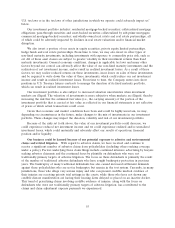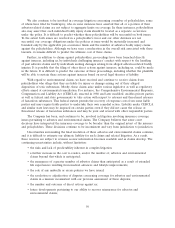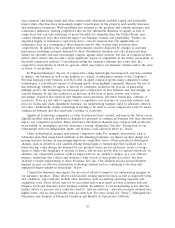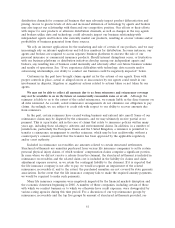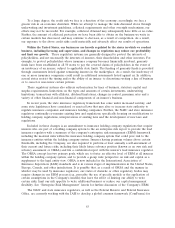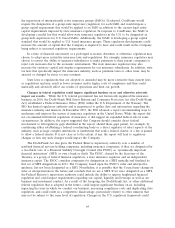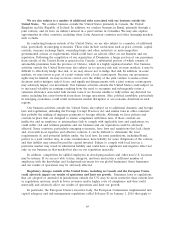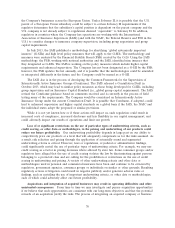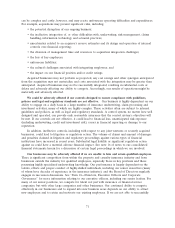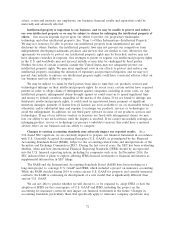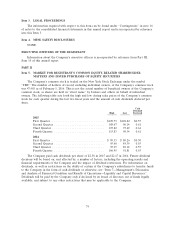Travelers 2015 Annual Report Download - page 65
Download and view the complete annual report
Please find page 65 of the 2015 Travelers annual report below. You can navigate through the pages in the report by either clicking on the pages listed below, or by using the keyword search tool below to find specific information within the annual report.impact the overall competitive environment by imposing additional burdens on us and allowing other
competitors not subject to these same burdens to enter or expand their insurance businesses.
Even if we are not subject to additional regulation by the federal government, significant financial
sector regulatory reform, including the Dodd-Frank Act, could have a significant impact on us. For
example, regulatory reform could have an unexpected impact on our rights as a creditor or on our
competitive position. In particular, the Dodd-Frank Act authorizes assessments to pay for the resolution
of systemically important financial institutions that have become insolvent. We (as a financial company
with more than $50 billion in assets) could be assessed, and, although any such assessment is required
to be risk weighted (i.e., riskier firms pay more), such costs could be material to us and are not
currently estimable.
Other potential changes in U.S. federal legislation, regulation and/or administrative policies,
including the potential repeal of the McCarran-Ferguson Act (which exempts insurance from most
federal regulation) and potential changes in federal taxation, could also significantly harm the insurance
industry, including us.
A downgrade in our claims-paying and financial strength ratings could adversely impact our
business volumes, adversely impact our ability to access the capital markets and increase our
borrowing costs. Claims-paying and financial strength ratings are important to an insurer’s competitive
position. Rating agencies periodically review insurers’ ratings and change their ratings criteria;
therefore, our current ratings may not be maintained in the future. A downgrade in one or more of our
ratings could negatively impact our business volumes because demand for certain of our products may
be reduced, particularly because many customers may require that we maintain minimum ratings to
enter into, maintain or renew business with us. Additionally, we may find it more difficult to access the
capital markets and we may incur higher borrowing costs. If significant losses, including, but not limited
to, those resulting from one or more major catastrophes, or significant reserve additions or significant
investment losses were to cause our capital position to deteriorate significantly, or if one or more rating
agencies substantially increase their capital requirements, we may need to raise equity capital in the
future (which we may not be able to do at a reasonable cost or at all, especially at a time of financial
market disruption) in order to maintain our ratings or limit the extent of a downgrade. A continued
trend of more frequent and severe weather-related catastrophes or a prolonged financial market
disruption or economic downturn may lead rating agencies to substantially increase their capital
requirements. See also ‘‘During or following a period of financial market disruption or economic
downturn, our business could be materially and adversely affected.’’ For further discussion about our
ratings, see ‘‘Item 1—Business—Ratings.’’
The inability of our insurance subsidiaries to pay dividends to our holding company in sufficient
amounts would harm our ability to meet our obligations, pay future shareholder dividends or make
future share repurchases. Our holding company relies on dividends from our U.S. insurance
subsidiaries to meet our obligations for payment of interest and principal on outstanding debt, to pay
dividends to shareholders, to make contributions to our qualified domestic pension plan, to pay other
corporate expenses and to make share repurchases. The ability of our insurance subsidiaries to pay
dividends to our holding company in the future will depend on their statutory capital and surplus,
earnings and regulatory restrictions.
We are subject to state insurance regulation as an insurance holding company system. Our U.S.
insurance subsidiaries are subject to various regulatory restrictions that limit the maximum amount of
dividends available to be paid to their parent without prior approval of insurance regulatory authorities.
In a time of prolonged economic downturn or otherwise, insurance regulators may choose to further
restrict the ability of insurance subsidiaries to make payments to their parent companies. The ability of
our insurance subsidiaries to pay dividends to our holding company is also restricted by regulations that
set standards of solvency that must be met and maintained.
65


